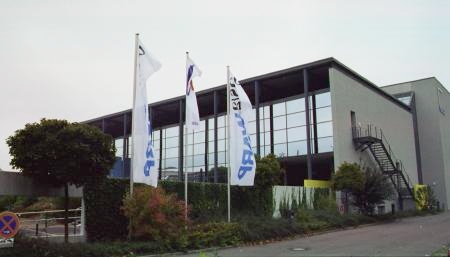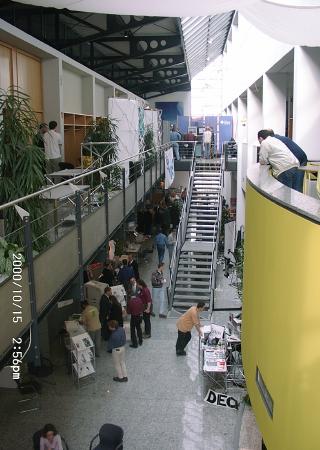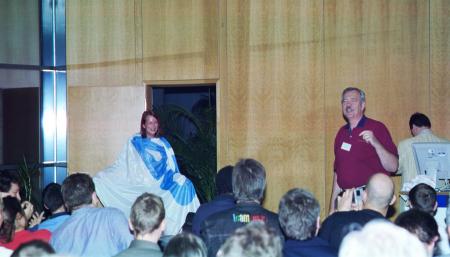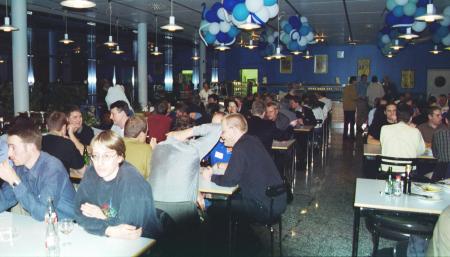
VOICE Home Page: http://www.os2voice.org
[Previous Page] [Next Page]
[Features]
 VOICE Home Page: http://www.os2voice.org |
[Previous Page] [Next Page] [Features] |
By Frank Berke & Christian
Hennecke, ©November 2000Warpstock Europe Homepage - http://warpstock.os2.org/en/ |
Photos are courtesy of Roland Junkers, Kim Haverblad and Wolfgang
Wilms and used with kind permission.
Like last year visitors came from all over Europe: e.g. Germany, Switzerland,
Denmark, Sweden, the Netherlands, Great Britain and Spain.
In relation to last year's event in Bochum the location was of a higher-class
and thanks to the excellent care by Fiducia's staff we were able to concentrate
more on the real organization. That resulted in a much higher number of exhibitors.
But more about that later. We did like Warpstock Europe very much and we are looking
forward to attending next year. Photos of the event will be available shortly at
the Warpstock Europe Homepage.

It was really nice to see all those faces and persons behind the names from the
newsgroups, the IRC nicks or the e-mail addresses. Several people turned out to
be quite different from what I had imagined. Those, who I had thought of as being
more of the leisurely, big kind turned out to be looking more ascetic and vice versa.
It's strange how you think about people's looks judging from their way of writing
or speaking on the phone. Well, I managed to meet Thomas Klein from our translation
team (I still owe him a beer). First I had imagined Kim Haverblad from OS2 World.com
as a quite young OS/2 enthusiast, but in reality he worked for IBM for several years.
Looks like I have been fooled by the analogy to Adrian Gschwend and Netlabs. Anyway,
Kim's energy is stunning and I hope that we will be able to make at least some of
his ideas reality.
Fortunately, I had the chance to attend Andreas Linde's highly interesting presentation
on building dynamic websites and to talk to him later. Andreas has agreed to help
VOICE with some things like building up the Warpdoctor site. Also generally speaking,
VOICE strives for closer cooperation with OS2.org.
For instance, they could also help us with maintaining and creating the Newsletter
and in turn VOICE could make available hardware and software reviews from the Newsletter
for including them into OS2.org's hardware compatibility list and the SoftWhere?
project.
As you can already see, there was extensive exchange among the visitors. Especially
developers could be seen all around sticking their heads together and discussing.
I hope that many good ideas and cooperation will emerge from this. At least, many
a person went home with the solution for a problem that had eaten at him/her for
a long time.
Alas, there was no VOICE booth in Karlsruhe. Frank and I were so involved in
the event's organization that we had no time left. But I held a presentation about
VOICE that was relatively well-visited, mainly by people from the German-speaking
countries, some of which I hopefully could persuade to join VOICE.
I haven't been able to attend all presentations I was interested in, for instance
"XWorkplace: Extending the Workplace Shell" by Ulrich Möller. But
I have been able to learn several interesting news.
At the keynote Oliver Stein explained IBMs future strategy for OS/2. For those
of us who regularly follow the common news resources there was not much news, but
he did say that we can expect further support from IBM for a minimum of five years,
depending on how the large customers decide in the future.
More important news was brought to us by the presentation on device drivers which
was held by Oliver Stein, also. IBM is currently heavily investing in development
of USB drivers for classes of devices that can be used with generic drivers. Belonging
to these classes are e.g. external mass storage devices like CD-ROMs, DVDs and CD-RWs.
For those, support should be available around the end of the year. Additionally,
drivers for the Belkin USB-to-parallel/serial interface are under development. Many
of you will surely like to hear that support for the OHCI standard is planned for
2001, though this isn't looked at with top priority.
As for their commitment to Linux IBM recently ported the OMNI driver system.
According to Mr. Stein IBM received many offerings for extending the driver with
specific features from printer manufacturers that didn't care at all about OS/2
support. OS/2 users are going to profit from this since IBM is going to re-port
those extensions. Mr. Stein demonstrated the capabilities of the new PCCard driver
by transferring photos that just had been taken with digital camera from the cameras
memory stick. Then we were able to see the new IrCOMM driver in action that he used
to read and write data from and to a mobile phone. To be able to do so a mobile
phone with a hardware modem is required. The IrCOMM driver sits on top of IBMs complete
IrDA stack that can also communicate with NICs and printers if additional drivers
are provided.
Support for the new USB 2.0 standard and the next version of the UDF filesystem
is also planned for next year. All these extension will only be available via Software
Choice or eComStation Upgrade Protection, however.
As at Warpstock USA the Odin team ensured full rooms. The number of already working
applications has increased a lot. The team received much applause when Achim Hasenmüller
started Microsoft Word and typed "Welcome to Microsoft Word for OS/2".
People were also very impressed by several games that ran without problems and with
decent speed. Even if Odin is not nearly complete yet, the progress that has been
made since the revival of the Win32-OS/2 project is stunning and Odin can already
be used for productivity.
Being one of the Newsletter's editors I naturally was keen on attending Esther
Schindler's presentation on product reviews. She gave us a very humorous view of
what goes on behind the scenes and of course hints on what to do and what to avoid.
In addition Esther and Bill Schindler attended as representatives of the Phoenix
OS/2 Society and showed its members' magazine Extended Attributes.
Zsolt Kadar introduced his package UpdCD for updating the Warp 4 installation
CD. Meanwhile it is capable of integrating additional packages like Java 1.1.8,
Netscape 4.61 and TCP/IP 4.1. In addition to his presentation he also showed the
software in live action and offered to visitors the opportunity to take an up-to-date
CD home if they were able to provide a proof of license. His CD writer had a lot
of work to do.
Rainer Feuerstein from IBM explained the methods to create bootable CDs for command
line, PM and WPS systems. Using them it is possible to create more or less standard
maintenance systems that can be used for purposes like backups or installing special
pre-configured OS/2 systems fast and convenient. For those interested Mr. Feuerstein
offered some CDs with a compilation of all necessary software.

The panel discussion about eComStation took place on Friday evening with Bob
St. John and Kim Cheung from Serenity
Systems, Oliver Mark from IBM, Achim Hasenmüller from Innotek
Software, Joachim Benjamins from Mensys
and Richard Spurlock from Starfire Technologies.
Interest was large and many didn't manage to get a seat in time. Surprisingly most
of the questions dealt with developer topics. But that only reflected the huge number
of developers in the audience. The impression we got was like what Achim Hasenmüller
said: That Serenity Systems really want to see their product succeed and that they
are highly motivated to fulfill their customers wishes. I was able to experience
this first hand on Saturday when Kim Cheung gave a demonstration for a few people.
I am an absolute greenhorn as far as things like remote maintenance and installation
are concerned. But nevertheless the demonstration of WiseManager's capabilities
was very impressing. You could also see Bob St. John and Kim Cheung talking to developers
a lot. I'm looking forward to see what will become of it.
In the non-commercial exhibition area you could see developers showing their
products, user groups presenting themselves and giving a helping hand to those with
problems with OS/2, and of course the people from OS2.org. Daniela Engert had brought
her hardware testing equipment with her, offered to have a look at "problem
children" and at the same time updated her drivers. Christopher Wohlgemuth
presented his CD-writing software Cdrecord/2
together with the Audio/Data-CD-Creator frontend, and a new version of CandyBarz
that looked really cool with transparency effects. Bill Ritcher from Guiffy
Software came all the way from the USA and brought his Java-shareware program
Guiffy, a tool for comparing and merging files that really can save you an awful
amount of time.
Nowadays you don't get to see new packages from the multimedia field very often
and accordingly Carsten Tenbrink's booth with Cinema/2
was always crowded with TV-junkies. The same was true for the technology demo of
a DVD video player by Rüdiger Ihle. I strongly hope that he will be able to
find someone who funds further development and finances those exorbitantly high
license fees, especially since the company that wanted IBM to develop a player has
canceled the project.
Meanwhile Jürgen Dankoweit has decided to continue development of Secure
Desktop again and has also taken over that of a package for HAM radio enthusiasts.
Karlheinz Schmidthaus took over for Harald Mayer and presented the new and feature-laden
ISDNPM 3.0.
From Great Britain came Dimitris Michelinakis from the Warp UK usergroup and
brought his server and firewall configuration and CONFIG.SYS maintenance tools
with him. Carsten Müller could not only be found representing Sun, but also
introducing people to the online forums of commTalk.de
that we heavily used for advertising by the way.
Cornelis Bockemühl competently and patiently explained the basics of astronomy
even to absolute beginners, demoing his freeware package PmAs.
Some may have a new hobby now. Timo Maier was there with his VIO packages ADRp,
Snee and Voldep. It's quite surprising how many people seem to have invested
in stocks.

The commercial exhibitors had much to show, too. Our main sponsor IBM
not only came with several speakers, but also presented e.g. two Netfinity servers,
each of which was equipped with four processors. The staff of VTS
Datensysteme demoed their products for network and server administration.
At Sun Microsystems' booth people gazed at
the new StarPortal. A Sun Sparc Ultra 60 provided the complete StarOffice functionality
that could be accessed from a machine running OS/2 as a Java application or from
a browser, and all this with decent speed. Unfortunately, I had no opportunity to
attend Starfire Technologies' presentation,
but the demo of Titan, a server management package with a web interface, at their
booth was extremely interesting.
HOB showed their products for remote access
to Windows machines, HOBLink JWT, and to machines running Unixes, HOBLink X11. They
told me some quite exciting news, especially for home users. So far there have been
performance problems with running local programs on a stand-alone machine. This
should be fixed soon. And HOB is also going to include support for the new X11R6.4
standard.
Artem presented their hardware solutions for
wireless networking. I heard that they are currently pushing development of OS/2
drivers for their product families and that they are thinking about offering a small
set for home users at a reduced price. Another company coming from the field of
communication was Hypercope, who provide
professional ISDN hardware.
Like last year EPSON attended the show. At
the booth you could see printers, of course, but also other hardware like scanners
that were running very well with PMSANE and SANE. Wolfgang Wilms, who also was a
member of the Warpstock Europe planning team, told us that EPSON is interested in
updating scanner support for OS/2. The neighboring booth of Lexmark
had plenty of printers to see, too. By the way, several visitors said they were
very pleased with the excellent advice and care from the EPSON and Lexmark staff,
for both professionals and endusers.
At the booth of Norman you were able to learn
about security solutions for networks. A topic that currently is talked about a
lot now, since the huge security leak in Microsoft's own network. The German distributors
Deckarm and Novastar
offered their products, e.g. Lotus Smartsuite and Impos/2. A choice of their books
at special prices, for example Oliver Mark's book on WSeB, was presented by C&L
Verlag.
Last but not least there was Mensys, of course.
Besides a wide range of OS/2 software you could also find here Bob St. John and
Kim Cheung from Serenity Systems with eComStation, which is distributed by Mensys.
When he wasn't holding a lecture or talking to developers, Kim Cheung gave some
very impressive demonstrations of WiseManager's capabilities using a diskless client.
Sadly, the Warped Jeopardy show that had been planned for Saturday evening had
to be canceled due to technical problems. Instead there was a raffle and Esther
Schindler played emcee. After that Oliver Mark donated one of the last large OS/2
flags for auction. Bob St. John took the part of auctioneer and proved to be a real
entertainer. On the spot he wrapped Daniela Engert into the flag. Something that
will surely be remembered for a long time. Anybody out there who does not have the
photo yet? Well, the flag was sold to Eirik Overby (Ltning on IRC in #voice) for
about 400 Euros. The money will be used for the next Warpstock Europe event.

Then the day closed with the "social event" that was completely sold
out though we managed to add some additional seats. At the beginning Kim Haverblad
announced the winners of the OS2 World.com Award and Warpstock Europe 2000 won in
the category "Best Event of the Year". The atmosphere was very comfortable
with music and nice food and people exchanged lots of OS/2 and other stories.

I really liked Warpstock Europe, even if I was much too busy. Next year I want
to see another "issue".
For me and several other members of TeamOS/2
Ruhr e.V. all began with a "failed" meeting: Thanks to the fully developed
information infrastructure of the board of directors of that time no small number
of members gathered at the wrong date, resulting in an unofficial meeting. We were
very lucky that Wolfgang Wilms was also there, who pulled something from his hat,
er, bag that many already believed they would see no more: The basic plans for Warpstock
Europe 2000, ready for presentation. In the months before he, together with Christian
Langanke, the current president of TeamOS/2 Ruhr e.V., had selected a location that
even IBM was happy with and that had nothing in common with the University of Bochum,
the location of 1999.
At the next regular meeting the cat was let out of the bag: Without much ado
all those tasks that had to be worked on with high priority (the year was almost
halfway over) were divided amongst the members. Christian Hennecke and I, spontaneously
volunteered for the acquisition of non-commercial exhibitors. We found the idea
of offering free booths, hardware (if needed) and free entry to developers, who
ask for no or little money for their software, to be simply brilliant.
Because as far as we knew this opportunities had not existed at any other OS/2
event, we thought that we would barely be able to stand the run. So we began silently
collecting ideas on whom to contact for a while. The problem of how to make a clear
distinction between small companies and "simple" authors of shareware
arose. One possibility would have been to divide by the distributing concept, but
we didn't want to upset anyone, since there are real companies behind some of that
which lies on Hobbes etc., declared as shareware.
So we decided by common sense and we think that we got it quite right.
While Christian and I surfed the WWW for hours at night, always searching for
OS/2 software and information on the related authors, the next problem knocked on
our door: Should we only consider developers, whose software existed on Hobbes or
LEO in a more or less up to date version, or should we also try to "re-activate"
programmers who hadn't updated their packages for a longer time? We opted for the
second variant because many of those packages were still available at BMT
Micro at that time (meanwhile their website has been heavily changed and I don't
know if that is also true for the catalogue) and there were several outstanding
packages that we wished to be continued.
Until our official deadline in the mid of September the database, which we used
to maintain our list of potential non-commercial exhibitors, had grown to exactly
107 entries, while we worked on contacting the candidates in portions. Only a few
developers from Germany or other near countries got surprised with an invitation
by phone, if we were able to find out the necessary personal data (the internet
carries more information than many would be fond of - but for us it would have been
best if all developers had exactly listed their contact address on their homepages
;-)
While the phone calls we made weren't always successful, but quite amusing most
of the time, asking via e-mail became a farce: At the end of August Christian and
I only managed to get confirmations from a handful (!) of people, so we already
feared that the developers would end up as a small, intimidated group, cowering
in a corner, afraid to be found by someone...
Fortunately, things ended differently from what we expected. In September a nice
number of people decided late but well, two of those being Daniela Engert and Zsolt
Kadar. Though both had made it quite plain before that they would attend and Zsolt
even agreed to hold a lecture on his new package, they both expressed their wish
for a "seat" later, something we of course were glad to comply with. These
two "late starters" were heaven sent for our marketing machine that was
always greedy for sensations. Where else can you experience "live driver development"
and have your Warp 4 CD updated? Such things are going to be remembered positively,
hopefully also by our visitors.
Extreme displeasure is what Christian and me feel when we think of the number
of those who in spite of being invited sometimes repeatedly! didn't even
condescend to send a negative reply. I don't want to resume on missing netiquette
here (Yes, also an e-mail is a real try to communicate with somebody. Wouldn't you
be put off, too, if somebody whom you spoke to went on without saying a word?),
but instead put the focus on what counts: OS/2.
What is OS/2 worth today without those who develop software for this platform?
Correct, nothing. But I am really starting to wonder at some developers' attitude
to this point. Many people (including companies) complain about missing sales in
the OS/2 area, which sooner or later leads to the point where they abandon OS/2
as a platform, their products vanish in a drawer and are left to be forgotten. However,
are the endusers always those to blame, because they keep their wallets locked out
of whatever reason? Or doesn't the guilt also lie with the developers themselves,
who can't or don't want to dispose of their software? Those who ignore the endusers'
opinion, who only offer their software on a homepage that's as hard to find as possible,
and who deliberately ignore the newsgroups and online forums shouldn't be surprised
at the "success" of their software.
This is called marketing, you know, and for me marketing also includes attending
fairs. Of course, I can understand, if someone from Australia, the USA, Italy, or
even from far eastern Germany is reluctant to spend his/her money on the costs for
traveling and accommodation. But a message saying so is the least one can expect,
as a simple reply takes a maximum of a on five minutes. If we can draw a conclusion
from such a behavior to the kind of support those programmers offer, I'm afraid
times are looking pretty dim.
I would have liked to be able to keep these remarks to myself and rather have
reported how flawlessly it all worked. But it didn't and where humans interact things
just can't work all flawlessly. But when about 50% of the potential feedback is
missing, something's wrong with the OS/2 community.
What was very encouraging for me were those people who attended Warpstock in
the end, but also those who declined our offer because of whatever reason. It is
an elevating experience to be able to gather the people who usually only meet in
Usenet - if at all - and to get them to know personally. Time and time again it
has proven to be true that these developers are no mouse-gray stay-at-homes, but
creative people, who are able to master life and who do OS/2 programming mostly
as a hobby.
The bottom line is a predominantly positive impression of Warpstock. We can pat
ourselves on the back with a certain amount of pride, but there's only little time
to relax. Already around the middle of November a meeting of the local TeamOS/2
groups under the roof of TeamOS/2 Deutschland takes place in Cologne, where we are
going to take stock of Warpstock Europe 2000 and also discuss next year's event.
We can only hope that the local groups will be willing to contribute more than this
year. Also help from outside Germany is very welcome, of course. In a small circle
with Kim Haverblad we already thought in this direction and I personally found his
opinions and visions to be very persuading. So I am sure that it's going to get
thrilling again.
I only hope that the preparations for Warpstock Europe 2001 will go off much
more smoothly than this year. To sustain the vision of an event from users for users
we will need much help. We can't manage to do it all alone, partially we simply
are missing ideas. We only can implore anyone who wants to contribute to Warpstock
in any form to really do it. It's supposed to get better, not worse.